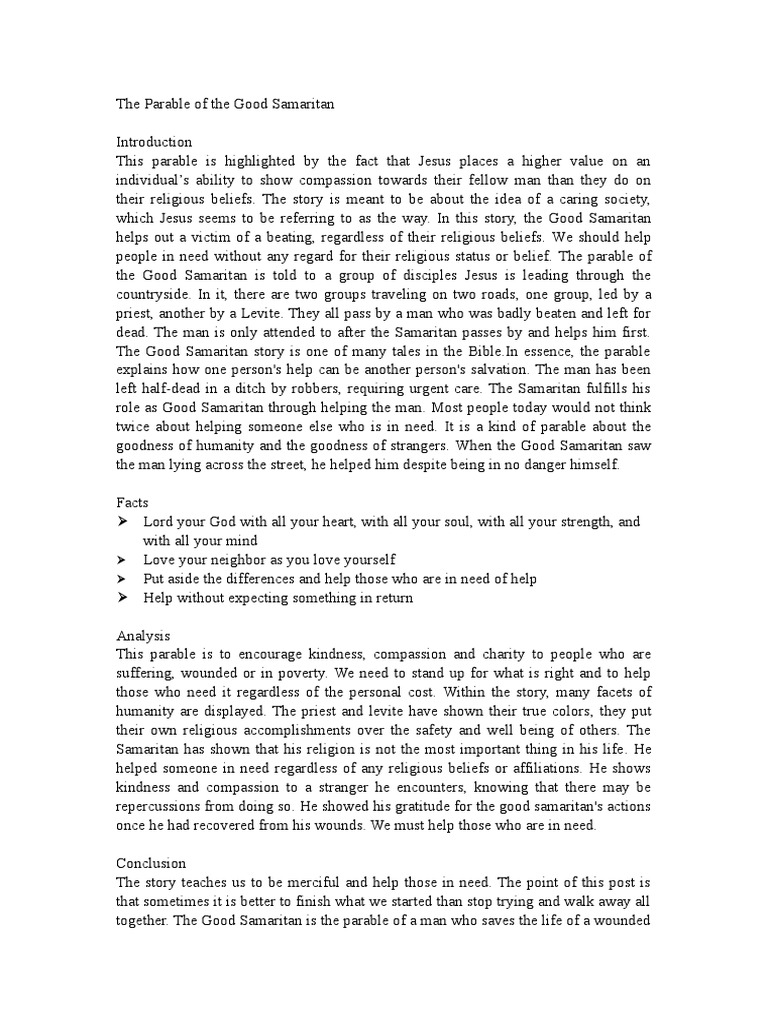In the realm of religious teachings, the Parable of the Good Samaritan stands as a profound narrative that transcends cultural and temporal boundaries. At its core, this parable conveys a message that aligns harmoniously with the principles espoused by the Bahá’í Faith. The convergence of this parable with Bahá’í teachings reveals a multifaceted understanding of love, compassion, and service to humanity that is crucial in today’s world.
The parable, recounted in the Gospel of Luke, depicts a man who is assaulted and left for dead on the side of the road. While a priest and a Levite pass him by, it is a Samaritan—a figure traditionally viewed with disdain by the Jewish community—who decides to help. This choice to assist the suffering individual, despite societal norms and prejudices, encapsulates the essence of selfless service and exemplifies the profound Bahá’í principle of viewing all humanity as one.
Humanitarian Awakening
Within the Bahá’í Faith, there is an intrinsic belief in the oneness of humanity. This belief resonates deeply within the parable, where the Samaritan exemplifies compassion for a stranger, breaking through the barriers of sectarian division. The narrative encourages a humanitarian awakening that beckons individuals to act not only in favor of those who align with their identity but also for those who inhabit the peripheries of society.
This motif of unity and collective responsibility is echoed in Bahá’í teachings, which advocate for the eradication of prejudice and the embracing of diversity. The Samaritan’s unwavering dedication to assist the wounded man serves as a clarion call to Bahá’ís to engage actively in humanitarian efforts and social justice initiatives, thereby amplifying the imperative to alleviate suffering.
Compassion as a Catalyst for Change
Moreover, the parable underscores compassion as a catalyst for transformative change. The Samaritan tends to the injured man’s wounds and ensures his recovery, illustrating that mere empathy is insufficient; action is imperative. This metamorphosis from an observer to an active participant in another’s welfare resonates profoundly with Bahá’í teachings, which prioritize the enactment of love and service above abstract ideals.
Incorporating the notion of compassion into daily life is not merely advisable but essential for fostering a harmonious society. Practicing compassion allows individuals to forge connections, cultivate understanding, and inspire collective action toward the betterment of humanity. The Samaritan’s actions challenge Bahá’ís to rise above indifference and apathy, demanding an engagement with the plight of others that is both heartfelt and tangible.
Confronting Societal Norms
The Good Samaritan’s willingness to defy societal norms encapsulates a daring challenge to the status quo. His actions prompt the reader to reflect on their compliance with social conventions that may perpetuate injustice or discrimination. The Bahá’í teachings advocate for the examination and reformation of societal dictates that desensitize individuals to the suffering of others. Every Bahá’í is called to scrutinize their biases and engage consciously in the healing of social rifts.
This confrontational aspect of the parable invites Bahá’ís to participate in dialogues that dismantle barriers and foster inclusivity. To embrace a spirit of collaboration, it is essential to confront prejudices that inhibit understanding and perpetuate division. The Samaritan’s actions invite Bahá’ís to have the courage to act righteously, despite the potential backlash from societal norms.
Empowerment through Action
Furthermore, the parable elucidates the concept of empowerment through action. Active engagement in the service of others fulfills not only a moral obligation but also catalyzes personal growth and enrichment. The Bahá’í perspective encourages individuals to embrace their responsibilities to their communities and the world at large, fostering a sense of belonging and purpose.
The motif of empowerment extends beyond individual acts of kindness. It encompasses the broader commitment to global issues such as poverty, inequality, and environmental degradation. Bahá’ís are urged to bring about systemic change through cooperative efforts, ensuring that philanthropic actions contribute to sustainable societal models. Here, the Samaritans of the modern age are those who activate their inner potential to forge resilience in communities striving for justice.
Lessons for Contemporary Society
The reverberations of the Good Samaritan parable in contemporary discourse enhance its appeal as a guiding framework for ethical living. The urgency for compassionate action is amplified in an era rife with conflict and division. The Bahá’í community is called to respond with compassion, instituting practices that advocate for justice and promote the welfare of humanity without exception.
This adherence to the core tenet of service catalyzes a movement of collective consciousness, whereby every individual becomes a steward of love and unity. The parable’s inherent metaphors compel a broader engagement with the world, allowing individuals to envision a future steeped in empathy and collaborative action. In fulfilling this vision, society can indeed transcend despair and fragmentation.
Conclusion: A Manifestation of Bahá’í Values
In conclusion, the Parable of the Good Samaritan serves as an emblematic narrative that integrates seamlessly with Bahá’í principles. It challenges individuals to embrace a holistic view of humanity, inspire compassionate action, confront societal injustices, and seek empowerment through unyielding service. As Bahá’ís navigate the complexities of the modern world, the essence of this parable remains foundational, extending an invitation to embody love, compassion, and solidarity in every facet of life.
